StoneAge
StoneAge (Originalregel)
Game preparation
With /join 2-4 players can enter the game. With /start the game begins. Alternatively, you can use the game management use.
The game
StoneAge is a stone age-based development game that offers many different possibilities and tactics to reach the goal. Whether you enter your points through buildings or civilisation cards, you must not forget to feed your people with enough food, because then there is a high point loss.
This online guide does not claim completeness and wants to explain handling. The original game rule can be on the publishing page as pdf file.
Field
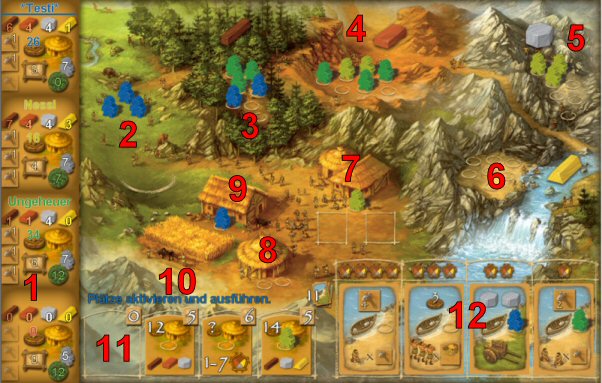
- Player display
- Raw material field hunting (food)
- Raw material field forest (wood)
- Lehmgrube raw material field
- Raw material field Steinbruch (stone)
- Raw material field River (Gold)
- Dorffeld Toolmaker (tool)
- Dorffeld Hütte (success)
- Village field Acker (food)
- Status display (Who is with what action?)
- Building maps
- Civilization cards
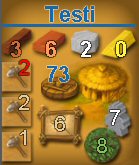
The raw materials (wood, brick, stone, gold) are listed below the player name.
The tools are displayed on the left edge. Used tools are shown in red.
In the middle above the wooden wheel you can see the current number of points (without civilization cards!), among them is the food display. At the right edge, below the cottage, the number of persons is indicated, among them in the green circle of the current food supply.

If you have a mouse over your gambler, you will get an overview of its collected civilisation cards: On the left are the cultural symbols, on the right the symbols for farmers, shamans, hut farmers and toolmakers (from top to bottom). Only your own cards are visible.
Game sequence
Each round runs in three phases:
- Use
- letting people act
- Feeding people
Phase 1: Use people
At the beginning, each player has five persons available, which he can distribute on the circles in the schedule. The starter starts and sets one or more people on a Place. To do this, it clicks on the corresponding field. In the raw material fields, it can add more people by clicking, as long as it remains above the field with the mouse and the green arrow is still displayed. To finish the move, move the mouse away from the field until the green arrow disappears. After that, all players also put one or more people on a Place. If a player has already set all persons, he will simply skip. This phase ends as soon as all players have placed all their available persons on the schedule or can no longer be placed.
The following rules apply to the use of persons:
The Raw materials fields (Jagd, Forest, clay pit, quarry, river) each have seven People's room. Exception: On the hunting field, the number of persons is not limited! If you already have people of your own colour in one place, you cannot place any other person. In the third-party game, a maximum of two colors may be represented on the raw material fields (except hunting), in the second-game only one color may stand there.
The Sugar and Toolmakers must be precise a Persons are set. The place in front of Cottage must two Persons of the same colour are occupied. In the game two and three only two of the three village fields (huts, field, toolmakers) can be occupied.
Civilization cards and building cards can be used by a Persons are occupied.
Phase 2: letting people act
After all people have been set, the starter lets his people act. To do this, he simply clicks on the desired person(sgroup). The order of action may be chosen freely by the player.

Acker: The food yield is increased by one (see Phase 3)

Toolmakers: The player gets a tool. The first three times the player receives a 1 tool. In the fourth to sixth time, one 1 is converted into a 2-tool, then the 2 in 3 in 3 and finally the 3 in 4er. A player can therefore have a maximum of three 4-tools (exception: unique tools through civilisation cards). The tools are needed to reduce raw materials more effectively (see raw materials fields).

Cottage: The two persons in the hut provide young people: From the next round, the player has a person more available for use. A player can overall over maximum 10 Persons have.
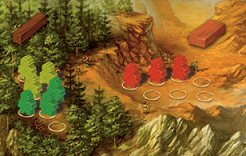
In all raw material fields, dice are diceed with as many dice as people of their own color are on this field. The total number of eyes is divided by the value of the responsive raw material: food (2), wood (3), brick (4), stone (5), gold (6). Thus, if, for example, red with three cubes casts a total of 13 eyes, it receives 13:4=3 bricks for this purpose.
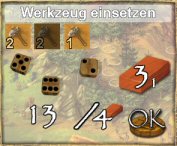
If the player is already in possession of tool, he can use it for a higher yield. It can use as many of its tool plates as desired to increase the number of eyes accordingly. Each platelet is used with its full value and cannot be used again in the same round.
Here in the example, Rot used one of the two tools beforehand. However, red can round its 13 with the two remaining tools to 16 and thus receives four bricks instead of only three. To do this, he simply selects the two tools and click OK. If you don't want to use tools, click OK without selecting tools. The lower number combination indicates the number of eyes and the value of the raw material. The large number on the raw material indicates the amount of raw material that is currently obtained and the smaller number shows the residual amount.

All building cards are distributed at the beginning on four stacks of seven cards. However, only as many stacks come into play as players play. At the lower edge of the maps, what is needed for building the building. At the top left is the result of the construction of this building. The number at the top right indicates how many cards are still on this stack. The building cards are in the appendix again described separately.
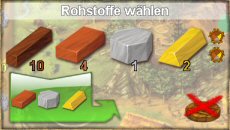
If a building map is occupied with one person, you can build this building if you can apply the necessary raw materials.
To do this, you simply select the specified raw materials and confirm its selection with OK. If you accidentally click on too many or wrong raw materials, you can reset them by clicking on them. If you do not want to build the building, you do not select raw materials and click on the crossed wooden wheel. If you do not have enough raw materials, the action will be skipped automatically.
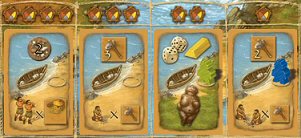
There are 36 civilisation cards in the game. Once one of the four open civilisation cards has been occupied, it is possible to record and execute them for the payment of raw materials. The price for the card depends on its location: The map to the right costs a (any) raw material (no food!), the map to the left and two raw materials, the next three and the map to the left costs four raw materials. Civilization cards have two areas: In the upper part, the advantage of this card (sofort) is shown, the lower part is important for the final score (see final score and attachment ).
To pick up the map, you can click a lot of raw materials in the popup window and confirm with OK. If you don't want the map, click on the crossed wooden wheel.
At the end of each round, the gaps are filled by first shifting the remaining cards from left to right and then adding them to the draw-down stack.
Phase 3: Feeding people
Now all people have to be supplied with food. For this, the number of food advertisements is added to the number of existing foods. The number of persons is now deducted from this. If there is not enough food for all, the complete food supply is first used up. After that, the player has the opportunity to replace missing food with raw materials. To do this, he clicks on many raw materials in the window and confirms with OK. Every raw material counts as a food, regardless of its value! If you have no raw materials or if you don't want to use them, you will get the point account 10 Points deducted. The score can also slip into the negative.
Then the starter changes and it starts a new round with phase 1.
Playing
The game ends when either one of the building stacks is empty (the running round is finished) or if the four civilisation cards can no longer be completely filled up at the end of the round. Then the final evaluation is still carried out.
Final value
In the case of brown civilisation cards, the number of figures is multiplied by the associated value:
- the number of peasants is multiplied by the number of food bar
- the number of toolmakers is multiplied by the number of tools
- the number of hut farmers is multiplied by the number of buildings built
- the number of shamans is multiplied by the number of persons
Other any raw materialwho has a player, a point.
Those who have the most points after that are winners. At the same time, the sum of food yields, tools and number of persons decides.
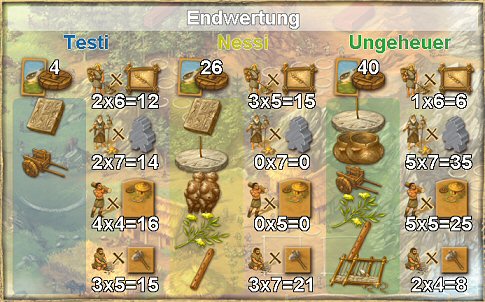
Let's go Example calculation the Civilization cards of monsters:
Six different cultural symbols (astronomy, pottery, transport, healing art, music, weaving) thus yields 6x6=36 points. Pottery and weaving are available twice, i.e. again 2x2=4 points, which then gives together 40 points.
On the right we have a peasant multiplied by the number of food ad (1x6=6). Among them five shamans multiplied by the number of persons (7) (5x7=35).
Then follow five hut builders with five built huts (5x5=25), as well as two toolmakers with four tools (2x4=8).

